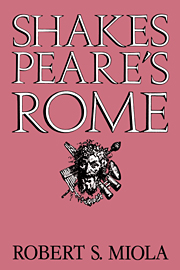Book contents
- Frontmatter
- Contents
- Acknowledgments
- Notes on sources
- I The roads to Rome
- II The Rape of Lucrece: Rome and Romans
- III Titus Andronicus: Rome and the family
- IV Julius Caesar: Rome divided
- V Antony and Cleopatra: Rome and the world
- VI Coriolanus: Rome and the self
- VII Cymbeline: Beyond Rome
- VIII Conclusion
- Index
III - Titus Andronicus: Rome and the family
Published online by Cambridge University Press: 28 October 2009
- Frontmatter
- Contents
- Acknowledgments
- Notes on sources
- I The roads to Rome
- II The Rape of Lucrece: Rome and Romans
- III Titus Andronicus: Rome and the family
- IV Julius Caesar: Rome divided
- V Antony and Cleopatra: Rome and the world
- VI Coriolanus: Rome and the self
- VII Cymbeline: Beyond Rome
- VIII Conclusion
- Index
Summary
Probably the most striking feature of modern critical reaction to Titus Andronicus is the persistent refusal to consider it one of Shakespeare's Roman plays. Early in the century, the abundant bloodletting and lurid action caused John M. Robertson to discern various hands in the play and to deny it a place in Shakespeare's canon. The disintegrationist furor having died down, most critics now emphasize the importance of Titus Andronicus to Shakespeare's artistic development, specifically to the histories and great tragedies that follow. Critics of Shakespeare's Rome generally follow the precedent of M. W. MacCallum, who relegates Titus Andronicus to a place apart from the Plutarchan tragedies:
It is pretty certain then that Julius Caesar is the first not only of the Roman Plays, but of the great series of Tragedies. The flame-tipped welter of Titus Andronicus, the poignant radiance of Romeo and Juliet belong to Shakespeare's pupilage and youth. Their place is apart from each other and the rest in the vestibule and forecourt of his art.
The vestibule has become a closet. Recent examinations of Shakespeare's Rome by Maurice Charney, Derek Traversi, J. L. Simmons, Paul A. Cantor, and Michael Platt either ignore Titus Andronicus completely or skim over it. Employing his three criteria for Romanitas – use of Roman costume, praise of suicide, source in North's Plutarch – Maurice Charney summarily dismisses Titus Andronicus: “Rome in Titus Andronicus is only the setting for a revenge play, which is based on such fictional classical themes as the Revenge of Atreus and the Rape of Philomela.” The play, however, gives ample evidence of Roman character.
- Type
- Chapter
- Information
- Shakespeare's Rome , pp. 42 - 75Publisher: Cambridge University PressPrint publication year: 1983



